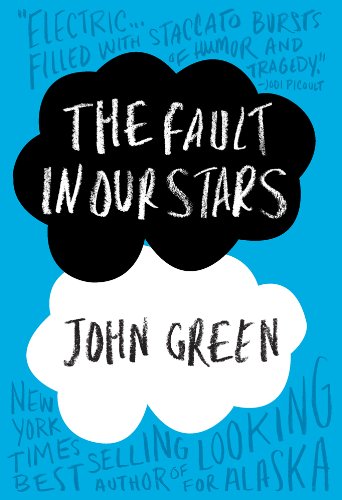
The Fault in Our Stars
Author: John Green
Publisher: Dutton Juvenile
Information: ISBN-13: 978-0525478812 | $17.99 US
OncoLink Rating: ![]()


Dear John,
The way I see it, John, it’s your fault. Totally your fault that yesterday I was at my local public library begging a children’s librarian for a copy of your latest young adult book, The Fault in Our Stars.
Seriously, there I was, on the second floor, in the children’s room, for crying out loud. Me – a middle aged library patron, demanding answers to three pressing questions: (#1) How many copies of The Fault in Our Stars does the library own? (#2) How long is the reserve list for the book? (#3) Is it really as good as everybody says?
That’s crazy!
The truth is I love to read. And I love the public library. But the children’s department with its picture books, stuffed animals and Lilliputian furniture is not where I typically hang out. Do you know what I mean?
But your books live here, John, when they aren’t in circulation, that is. And since I might be a John Green fan-in-training, I’m where I need to be, feeling like the proverbial stranger in a strange land.
Did I mention that the moment I entered the children’s room I bumped into a horde of rowdy pre-schoolers way overdue for their naps coming out of morning story time? Trust me when I say that it wasn’t pretty.
John, it might interest you to know that in this particular public library, the YA stacks are on the far side of the children’s room, nowhere near Eric Carle or Dr. Seuss. Books for teen readers are over by the windows; right next to a colorful poster that features Kristen Stewart and that pale-faced dude Robert Pattinson, in character as Bella and Edward.
Okay, now I’m just rambling…
I’m a reader who loves fiction, but when it comes to OncoLink and the blogging I do, fiction is not typically what I review. I guess I should also mention that I’m a 14 year breast cancer survivor and cancer books are my specialty. Guilty pleasure, actually. And these books typically land in non-fiction, biography and memoir. But for The Fault in Our Stars, I felt compelled to make an exception.
Yes, everybody’s buzzing about The Fault in Our Stars – online as well as in book publishing journals and mainstream magazines. The word on the street is that it’s already been optioned to be turned into a movie.
But back to children’s room…
This public library owned three copies of The Fault in Our Stars and unfortunately they were all signed out. The bad news kept coming: ten people were ahead of me on the waiting list. I didn’t care for those odds at all. But it might please you, John, to know that the librarian (who was otherwise busy checking out copies of Curious George and The Lorax) got absolutely teary-eyed as she talked about how wonderful The Fault in Our Stars is.
“It’s well worth the wait,” she said. “But I warn you, once you get into it, you better have a big box of Kleenex handy.”
So I did what I had to do. I drove to another library where I had a borrowing card and got lucky. Incredibly lucky because they had a copy of The Fault in Our Stars and it was just sitting there on the adult express read shelf. Isn’t that interesting? I couldn’t have been happier. I checked the book out, hurried home and inhaled The Fault in Our Stars in one very satisfying sitting.
Bottom line: I love it when a book lives up to all the advance hype surrounding it.
The Fault in Our Stars is a novel featuring two teenagers who aren’t vampires or wizards. And that’s a good thing! In fact, the book’s main characters, Hazel Lancaster and Augustus Waters are cancer patients who “meet cute” in a cancer kids support group meeting and develop a romantic relationship.
There’s so much for cancer patients of all ages to love about this book.
Let me start with the dialogue. When these teenagers complain about cancer treatment, their conversations are filled with wisecracks that hit the mark:
The nurse left. “Is she gone?”
I nodded, then realized he couldn’t see me nod. “Yeah,” I said…
“Qualities of a good nurse: go,” I said. “Go,” I said.
1. “Doesn’t pun on your disability,” Isaac said.
2. “Gets blood on the first try,” I said.
“Seriously, that is huge. I mean is this my freaking arm or a dartboard?”
3. “No condescending voice.”
“How are you doing, sweeties?” I asked, cloying. “I’m going to stick you with a needle now. There might be a little ouchie.”
“Is my wittle fuffywump swickywicky?” he answered. And then after a second, “Most of them are good, actually. I just want the hell out of this place.”
Interviews with the author suggest that he spent time working as a student chaplain at a children’s hospital. Ever since then, he wanted to write a novel about teenagers with cancer. Then John Green met and became friends with a 16-year-old fan of his books named Esther who had cancer and died last year. So while the author insists that The Fault in Our Stars is a work of fiction, the “Esther Connection” may be one reason why the book nails the CancerLand details so authentically.
Here’s another excerpt from the book that will no doubt ring true to anyone who spends time in CancerLand. Augustus and Hazel take a trip together and because of their physical disabilities, feel intensely self-conscious in the airport:
I could feel everybody watching us, wondering what was wrong with us, and whether it would kill us, and how heroic my mom must be, and everything else. That was the worst part about having cancer, sometimes: the physical evidence of disease separates you from other people. We were irreconcilably other, and never was it more obvious than when the three of us walked through the empty plane, the stewardess nodding sympathetically and gesturing us toward our row in the distant back.
Perhaps my favorite part of the book is when the heroic cancer patient script is kicked to the curb. Here’s an excerpt where the two teenagers chat about Caroline, a girl who died from her disease:
Like, you are familiar with the trope of the stoic and determined cancer victim who heroically fights her cancer with inhuman strength and never complains or stops smiling even at the very end, etcetera?”
“Indeed,” I said. “They are kindhearted and generous souls whose every breath is an Inspiration to Us All. They’re so strong! We admire them so!”
Right, but really, I mean aside from us obviously, cancer kids are not statistically more likely to be awesome or compassionate or perseverant or whatever. Caroline was always moody and miserable,…I mean, to be honest, she was a bitch. But you can’t say that, because she had this tumor…and she had plenty of reasons to be unpleasant, you know?”
The Fault in Our Stars is a book that explores important issues, life and death concerns that rarely take center stage in YA literature. Augustus and Hazel are star-crossed lovers whose relationship is certainly doomed; we gradually learn how advanced their cancers are. But their shared desire as a couple to experience life intensely in the time left to them is incredibly moving and poignant. The big questions they pose about the meaning of life in the face of premature death are questions that concern all human beings:
“…the problem is not suffering itself or oblivion itself but the depraved meaninglessness of these things, the absolutely inhuman nihilism of suffering. I thought of my dad telling me that the universe wants to be noticed. But what we want is to be noticed by the universe, to have the universe give a shit what happens to us – not the collective idea of sentient life but each of us, as individuals.“
Augustus and Hazel are fictional characters who are written as believable, bright, articulate young people. It is John Green’s artistry that brings them to life so memorably on the page. They stayed with me for weeks after finishing The Fault in Our Stars. As readers we quickly come to care about them and invest in the decisions they make. And just when you think you can predict what will happen in the next chapter, the author leads you down a far more interesting path. When it comes to reading, what could be better than that?
